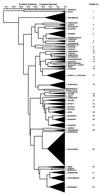Usefulness of fatty acid composition for differentiation of Legionella species
- PMID: 10364593
- PMCID: PMC85129
- DOI: 10.1128/JCM.37.7.2248-2254.1999
Usefulness of fatty acid composition for differentiation of Legionella species
Abstract
Numerical analysis of fatty acid methyl ester (FAME) profiles of 199 isolates and 76 reference strains, belonging to all validly described species of the genus Legionella that can be cultured in laboratory media, was used to differentiate between the species of this genus. With the exception of the strains that autofluoresced red, it was possible to differentiate all the other Legionella species. The strains of the species L. bozemanii, L. dumoffii, L. feeleii, L. gormanii, L. maceachernii, L. micdadei, and L. quinlivanii did not form single clusters, showing some degree of variability in the fatty acid compositions. The strains of the blue-white autofluorescent species had very similar fatty acid compositions and were difficult to distinguish from each other. Nine isolates had fatty acid profiles unlike those of any of the validly described species and may represent different FAME groups of known species or undescribed Legionella species. The method used in this study was useful for screening and discriminating large number of isolates of Legionella species. Moreover, the results obtained can be included in a database of fatty acid profiles, leading to a more accurate automatic identification of Legionella isolates.
Figures
Similar articles
-
Differentiation of Legionella species by soluble protein patterns in polyacrylamide slab gels.Microbios. 1987;52(211):105-14. Microbios. 1987. PMID: 3695990
-
Composition of 2,3-dihydroxy fatty acid-containing lipopolysaccharides from Legionella israelensis, Legionella maceachernii and Legionella micdadei.Microbiology (Reading). 1994 Jun;140 ( Pt 6):1261-71. doi: 10.1099/00221287-140-6-1261. Microbiology (Reading). 1994. PMID: 8081491
-
Rapid detection and typing of pathogenic nonpneumophila Legionella spp. isolates using a multiplex real-time PCR assay.Diagn Microbiol Infect Dis. 2016 Apr;84(4):298-303. doi: 10.1016/j.diagmicrobio.2016.01.007. Epub 2016 Jan 12. Diagn Microbiol Infect Dis. 2016. PMID: 26867966 Free PMC article.
-
[Molecular typing of Legionella for determining the source of infection].Immun Infekt. 1995 Feb;23(1):15-8. Immun Infekt. 1995. PMID: 7698807 Review. German.
-
[Methods and problems of Legionella diagnosis].Immun Infekt. 1989 Feb;17(1):4-12. Immun Infekt. 1989. PMID: 2647625 Review. German.
Cited by
-
Pangenomic analysis identifies correlations between Akkermansia species and subspecies and human health outcomes.Microbiome Res Rep. 2024 Jun 11;3(3):33. doi: 10.20517/mrr.2024.09. eCollection 2024. Microbiome Res Rep. 2024. PMID: 39421249 Free PMC article.
-
Rapid identification of clinically relevant Legionella spp. by analysis of transfer DNA intergenic spacer length polymorphism.J Clin Microbiol. 2001 Jan;39(1):162-9. doi: 10.1128/JCM.39.1.162-169.2001. J Clin Microbiol. 2001. PMID: 11136765 Free PMC article.
-
Presence and persistence of Legionella spp. in groundwater.Appl Environ Microbiol. 2005 Feb;71(2):663-71. doi: 10.1128/AEM.71.2.663-671.2005. Appl Environ Microbiol. 2005. PMID: 15691915 Free PMC article.
-
Native valve endocarditis due to a novel strain of Legionella.J Clin Microbiol. 2011 Sep;49(9):3340-2. doi: 10.1128/JCM.01066-11. Epub 2011 Jul 27. J Clin Microbiol. 2011. PMID: 21795511 Free PMC article.
-
Description of Stenotrophomonas sepilia sp. nov., isolated from blood culture of a hospitalized patient as a new member of Stenotrophomonas maltophilia complex.New Microbes New Infect. 2021 Jul 17;43:100920. doi: 10.1016/j.nmni.2021.100920. eCollection 2021 Sep. New Microbes New Infect. 2021. PMID: 34457314 Free PMC article.
References
-
- Benson, R. F. Personal communication.
-
- Benson R F, Thacker W L, Daneshvar M I, Brenner D J. Legionella waltersii sp. nov. and an unnamed Legionella genomospecies isolated from water in Australia. Int J Syst Bacteriol. 1996;46:631–634. - PubMed
-
- Birtles R J, Rowbotham T J, Raoult D, Harrison T G. Phylogenetic diversity of intra-amoebal legionellae as revealed by 16S rRNA gene sequence comparison. Microbiology. 1996;142:3525–3530. - PubMed
-
- Brenner D J. Classification of Legionellaceae. Current status and remaining questions. Isr J Med Sci. 1986;22:620–632. - PubMed
-
- Brenner D J, Steigerwalt A G, McDade J E. Classification of the Legionnaires’ disease bacterium: Legionella pneumophila, genus novum, species nova, of the family Legionellaceae, familia nova. Ann Intern Med. 1979;90:656–658. - PubMed
Publication types
MeSH terms
Substances
LinkOut - more resources
Full Text Sources


